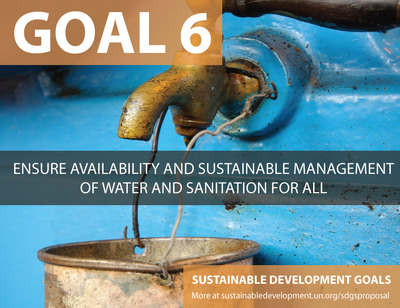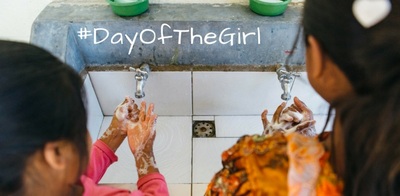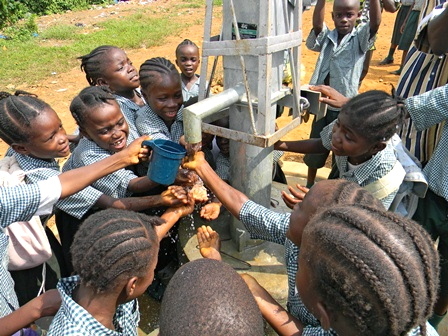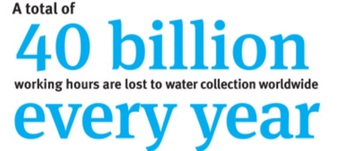Having worked on water projects in my past at Bechtel, I recently connected with Eleanor Allen, CEO of Water For People.
 Eleanor Allen is fiercely compassionate about improving global water and sanitation services. She believes societal change can be accelerated through social entrepreneurship and organizations like Water For People, a global nonprofit working with four million people in nine countries in Africa, Latin America, and India. As the CEO of Water For People, she keeps her organization transparent and cooperative, providing leadership in development work in water, sanitation, and hygiene. She has lived and worked all over the world and speaks four languages.
Eleanor Allen is fiercely compassionate about improving global water and sanitation services. She believes societal change can be accelerated through social entrepreneurship and organizations like Water For People, a global nonprofit working with four million people in nine countries in Africa, Latin America, and India. As the CEO of Water For People, she keeps her organization transparent and cooperative, providing leadership in development work in water, sanitation, and hygiene. She has lived and worked all over the world and speaks four languages.
1.8 billion people around the world don't have access to safe water and 2.4 billion (32% of the world's population) lack access to adequate sanitation. Women and children spend more than 4 hours walking for water each day, and more than 840,000 people die each year from water-related disease. 500,000 children die from drinking contaminated water. Until everyone has access to safe and reliable drinking water, the death toll will continue to rise. But is the global water crisis bigger than public health?
Below is an interview summary with Allen covering numerous aspects of the water crisis and how this is one of the major gender related crises across the world.
Why is clean water a global issue?
Over 25% of the world still does not have access to clean water. Pressures from population growth, urbanization, poverty, and conflict cause competition for sometimes scarce water resources. Where there is insufficient clean water for basic needs, health, education, and economic productivity are directly impacted, and social progress is impaired. Climate change means more extreme weather - droughts and flood. Industrialization without enforced environmental regulation negatively impacts surface and groundwater quality. Communities and regions without the means and institutions to build and maintain clean water and sanitation systems are disproportionately adversely affected. Conflict creates situations where services are limited at best. The global water crisis is considered the top global risk for the next ten years.
The global water and sanitation crisis is solvable.
In fact, the U.N's Sustainable Development Goal #6 (SDG6) has set the timeline - 2030 - "Ensure availability and sustainable management of water and sanitation for all."
Water - Is it distribution or supply issue & do we have enough of it?
We do, in theory. Even with rising populations, the problem is not the amount of fresh water available (which is finite). The challenge is getting it properly distributed and managed. Some places have too much, others too little; and everywhere, it takes strong institutions and coordinated effort to make water clean and safe, flowing, allocate it fairly between users. All around the world groundwater supplies are being depleted in unsustainable ways, surface and groundwater supplies are becoming more contaminated, aging infrastructure is causing an increase in water losses and non-revenue water, and growing populations along coastlines are resorting to more expensive desalination because freshwater supplies are insufficient. The portfolio of water resources management increases in complexity as the population grows. We are also becoming smarter and, in some places, managing these precious resources more wisely.
How is water a women's issue?
In the United States many are unaware that in developing countries the burden of hauling water rests primarily on women and girls, and the average distance they carry their water (5 gallons equals 40 pounds = HEAVY) in Africa and Asia is 3.5 miles. Women spend several hours every day collecting water.
This directly affects girls' education and women's ability to work and tend to their families, which negatively impacts their quality of life and limits their opportunity for progress.
Imagine what it would be like if we had to spend a chunk of our day, every day, carrying water. What that would do to our paychecks, or our daughter's education? It would be a whole different life. And it is.
Lack of access to water affects girls adversely for all the reasons mentioned above. Also, most schools in development countries don't have toilets. Not having a toilet means that when girls reach puberty they often miss a week of school a month or drop out when because there is no place to change their pads when they have their periods. 1 in 4 girls does not finish elementary school vs. 1 in 7 boys, which leads to 2/3 of all illiterate adults being women. Lack of proper facilities also leads to much higher risk of rape.
Does water effect education and the economy in developing countries around the world?
There is a direct, negative impact on the economy. Poor sanitation, water, and hygiene lead to about 675,000 premature deaths annually, and estimated annual economic losses of up to 7% of GDP in some countries. This is because of poor health, sickness, and lack of productivity. People who are spending their days walking miles to get water, who are afflicted by diarrhea, or who are tending to family members who are sick, often are relegated to subsistence farming or informal sector jobs like street hawking. Then there is also the link between poor water quality and malnutrition. Malnutrition affects 20% of the population in developing countries and is especially prevalent among those with inadequate access to clean water and proper sanitation. When malnourished children do go to school, they often have chronic parasites from poor quality water and are effectively "starved," which can result in stunting.
Does the United States have water vulnerabilities?
While water is always a local issue, it is more often becoming a global issue. The US faces every kind of water challenge faced by the developing world, and we can learn from each other. While many countries are still building their water and sanitation infrastructure for the first time, we are having trouble keeping ours working properly to maintain our high level of service. We take our water and wastewater utilities for granted because we always have clean water and flushing toilets at home. This is our invisible infrastructure that always works. Out of sight, out of mind. And when suddenly it doesn't work things are tough. Living without clean water has a significant impact on our lives - health, time, and productivity.
The silver lining following the Flint water crisis is that the vulnerability of our complex infrastructure systems was exposed. Mismanagement of water services can be catastrophic and was in Flint. Across the US we have not invested enough in proper maintenance of our infrastructure over the past few decades - it gets a D+ rating.
Situations like the one in Flint becomes more likely each day. The real cost of quality water service is often much more than we pay and our infrastructure is decaying from lack of investment. Americans have been reluctant to pay for proper infrastructure maintenance, feeling that something as ubiquitous as water should be free, or close to it. Interestingly, water and sanitation were officially declared to be "human rights" by the UN in 2010 and then amended in 2015 to also be "... accessible and affordable...".
Additionally, parts of the US suffer from persistent drought and water scarcity that will only be fixed via concerted efforts and coordinated water resource management with multiple stakeholders: residents, businesses, state governments, municipalities, utilities, developers, tourism industry, farmers, energy industry, environmental and citizen's groups.
Finally, there are many nearly-invisible, disadvantaged communities all around our country who live outside of any municipal water system, may not be connected to sewerage and may lack the means for onsite treatment (like septic tanks). These communities deserve to have reliable and quality water and sanitation services - just like the rest of the world does.
What are the barriers to solving this problem in our lifetime?
Political will, global leadership, investment, and corruption are the major barriers we face. A movement recently is the passage of the Sustainable Development Goals (SDGs). It will take $114 billion a year for the next 14 years to get clean water and working toilets to everyone on the planet and meet SDG6. That sounds like a lot of money, but is a small fraction (0.2%) of the world's GDP of $73 trillion/ We spent $67 billion in the US alone shopping last year on Black Friday!
That would have gone a long way towards helping more people get sustainable access to clean water and sanitation. But philanthropy alone is not going to solve this-it is one small piece of the puzzle. The big increase needs to come from government investment of tax revenues and through Official Development Assistance, which in 2011 was $7.6 billion for water and sanitation. The money is out there - we just need to redirect it. There also are huge losses annually on corruption - one estimate is more than 5 percent of global GDP each year or $2.6 trillion. Just a bit of that would help!
We need investment in infrastructure, AND institutions, to operate and properly maintain that infrastructure at the local level.
How can technology help solve this problem?
Good technology is necessary but not sufficient for the world to achieve SDG6. We are diligently working in the water, sanitation and hygiene (WASH) sector to understand what technologies are most appropriate for local conditions, what designs people want and can afford, and what infrastructure they will maintain for the long term. This will drive demand, and market forces will respond to provide services to increase water and sanitation coverage. When people value and covet their possessions, they are willing to invest in them and take care of them. This is also true for water and sanitation technologies and services. We have to remember that technology is not a silver bullet, and no one should be waiting for the magic pump or toilet to be invented to bring an end to the water and sanitation crisis. Solutions such as automation and remote monitoring can certainly help maintain reliability as system solutions become more complex.
Leading the charge
There are numerous international bodies driving efforts to raise awareness, raise private money, increase government spending, etc. Ultimately, national governments are the most effective leaders for permanent change in their countries. That is where Water For People is putting its energies, along with Agenda For Change, a collaboration of partners working with national governments to reorient the water and sanitation sector around sustainable services - not just building infrastructure. We are following the principles of Sanitation and Water For All to achieve universal access to clean water and adequate sanitation.
Water is Sustenance - How can you help?
Spread the word about the global water crisis to raise awareness. Let your congressional representatives know that you value US participation in solving the water crisis. The US Global Leadership Coalition is one organization that helps educate our elected officials about the importance of development to the US economy and why the International Affairs budget is critical. It helps build economic prosperity by developing international markets, driving economic development, creating American jobs, and expanding exports. You can make others aware of this too. Connect the dots: find out about how water issues play out in your community/town/state/country and make your lifestyle, consumer and voter choices accordingly. Invest in the solutions and in organizations that are creating impact and helping solve the crisis.
We need our governments and civic leaders thinking about the importance and value of safe water and sanitation for humanitarian reasons - because everyone deserves these basic services - and also because of the uplift it has on the global economy.
Check out www.waterforpeople.org, like our Facebook page, and follow us on Twitter and Instagram so that readers can learn more. Naturally we'd also love for readers to donate so that we can continue our important work on this global issue. They can also follow me at on Twitter @EleanorH2O to see what I am up to and get more ideas on how they can help!
For more information check our Eleanor Allen's TEDx talk



